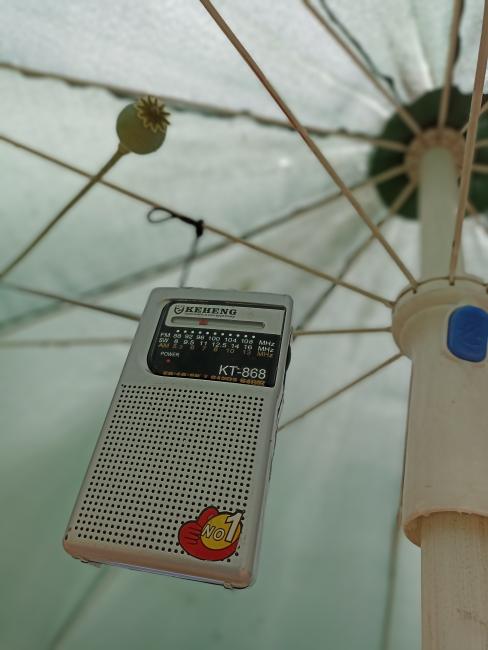In the home office, the world is shrinking to the size of a desk globe. Travelling to distant countries is currently only allowed with a finger on the rotating globe. But there is one device that has been able to bring the whole world into your own room for a hundred years now: the radio. You can surf the airwaves with your finger on the tuning button. In the past, it was the shortwave band that brought broadcasts from distant countries to your ears. Today, it is the internet.
However, the radio not only brings many different voices, sounds and news into your room, but is still the most reliable source of information, as FM radio still works even if there is no electricity (and thus no internet). So don't throw away your radios and check if you have enough batteries!
Meanwhile, I have been browsing the internet to see what radio archives and exciting radio stations there are for contemporary historians to discover. I promise acoustic journeys through time and around the world....
Did you know that the British Library is the home base of the National Sound Archive? 6.5 million recordings are preserved there, including the National Radio Archive, which not only archives BBC programmes, but also those of community radio stations. There are said to be a good 700 radio stations on the island. The archive is still under construction, but the aim is ‘to create a digital radio archive which will preserve a representative proportion of ongoing UK radio output.’ There is already a blog that presents acoustic finds almost daily. I particularly liked a blog entry about the necessity of dusting books.
Speaking of Great Britain. One of the most influential radio DJs ever was John Peel. The Englishman began presenting at small local radio stations in the USA in the early 1960s, but he became famous when he hosted the programme "The Perfumed Garden" on a pirate radio station in 1967. This was because the BBC didn't want to play the really cool rock music, so some enthusiasts sent from ships the new beat music through the airwaves to the island and got young people hooked on these sounds.
However, John Peel never stood still musically, he just kept playing only the music that was new and cool on his radio shows, whether it was punk or reggae, Bulgarian women's choirs or Jimi Hendrix. Andy Linehan, British Library Sound Archive's Curator of Popular Music, said of Peel's record collection that it was ‘legendary, unique and breathtaking, a piece of contemporary history’. Exactly! The record collection has indeed been archived and can be viewed here. The majority of his radio broadcasts have also been digitised. The quality of the recordings varies greatly, but hey, the mono cassette recorder under the blanket didn't sound much better back in the 1980s.
Radio history was also made by someone else in a completely different way, namely Orson Welles. Yes, the very man who made film history with such great films as ‘The Trial’, ‘Citizen Kane’ and ‘The Third Man’. Before Welles became known as a film director and actor beyond New York, he worked for the theatre –
And once you have immersed yourself in the time tunnel and become addicted to the sound of the early days of radio, you can stay tuned. The creators of the Relic Radio website see themselves as archaeologists of classic radio drama. Accordingly, they not only present more than 200 other shows by von Orson Welles, but also many other finds from the 1920s to the 1960s of radio history.
Shortly after 1938, a war did indeed soon begin, which even the USA could not evade. After World War II, the Cold War began, which also raged on the airwaves. Radio Free Europe, whose first station went on air in Munich in 1950, played an important role. Funded by the United States Congress, RFE saw its mission as providing people in the so-called Eastern Bloc countries with news from the West. Unlike the so-called soldier stations of the Allies, which were primarily established to entertain the soldiers, the RFE stations, later Radio Liberty, were specifically designed as news stations. They broadcasted in the language of the target country, which defended themselves accordingly with jammers.
The Hoover Institute at Stanford has made some Radio Free Europe programmes available online. If I have researched correctly, there are over 7,000 of them. You can listen to the programme "What do they really think of us?" from 1951. In a quarter-hour radio feature, Czechoslovakian exiles, among others, are asked about their perspective on the USA. I am surprised by how much the report makes use of the dramaturgical means of radio plays. At times, it sounds like the staging of a horror novel.
The Hoover Institute was founded 100 years ago and is regarded as a conservative think tank. The extensive archive focuses on sources from the First and Second World Wars. The Open Society Archives in Budapest offer a digitised collection of over 70,000 broadcast manuscripts. By teh way, we have archived a large and relatively unique collection of broadcast manuscripts in the ZZF library (see Z 90 and Z 643 to Z 675).
And Radio Free Europe still exists.
Let's jump to the present and to another continent, to Africa. Two years ago, I had the honour of getting to know radio artist Claudia Wegener and her impressive project radio continental drift, which she founded 15 years ago. Since then, she has been travelling the continent with a kind of portable radio studio, a ‘Broadcasting House in a listener's pocket’, empowering women in particular to tell their stories and learn the craft of radio making. For example, in the Zambezi Valley, in the border region between Zimbabwe and Zambia. The community radio station established there, Zongw FM, serves the Tonga people, separated by the river, as a means of communication: "This is a radio-bridge across the Zambezi and across the world..."
In addition, digital age allows for online presentation, making the voices of women audible far beyond national and tribal borders.
Claudia Wegener sees herself and her work as a switchboard, a transistor space that connects local projects, artists and listeners. The radio broadcasts and field recordings can be found under a Creative Commons licence in the internet archive and on her blog.
I am fundamentally convinced that radio can still move or irritate the world. The best proof for me was the Radio Revolten, which took place in Halle in October 2016 and which also created an archive. For a month, radio artists from all over the world met and made radio day and night (as well as exhibitions, performances, and eventually a book). What can I say: it was ear-opening and great!
The radio revolts were initiated by the Halle community radio station Radio Corax, dwhich has been broadcasting on FM for 20 years and is thus one of the longest-running free radio stations in Germany. Corax is a member of the Bundesverband Freier Radios (Federal Association of Free Radios) and, like many free radio stations, makes its broadcasts available for re-use on the Audioportal Freier Radios (Free Radio Audio Portal). In the ZZF area, Radio Corax's morning magazine programme can always be received on weekdays from 7 a.m. to 10 a.m. on FM Berlin 88.4 and in Potsdam on 90.7. My favourite show, SUBjektiv, can be heard live on the internet every Monday from 9 to 10 p.m. For 20 years, Corax managing director Mark Westhusen and Michael Nicolai have been playing there Pünk, as they like to call their favourite music. Of course, there is also a broadcast archive.
Finally, a note on a radio programme that can also function as time travel, except that it often takes you to much more distant time zones, which is not only due to the age of the presenter. And like Orson Welles, my favourite radio presenter is also famous for something other than his great radio shows. Because Bob Dylan earns his money rather with self-written songs. But from 2006 to 2009 – in addition to his Never Ending Tour around the world - he produced weekly one-hour themed radio shows, which beautifully represent an archaeology of American music. What do I particularly like? Honestly? His voice! I think Bob Dylan has an ideal radio voice with his mumbling, restrained, dark timbre. When he presents finds from his record collection with it, he also reveals his own sources. And he does so very sympathetically as a fan and with great respect, but also with irony in his selection for the playlists on such nice topics as weather, nothing, shoes or cars. The 100 radio shows of the "Theme Time Radio Hour" are staged in a very charming retro style, including fake callers and clips of friends such as Cat Power and Elvis Costello. And they are all available to listen to in the Internet Archive .
Have fun browsing acoustically and stay tuned in your home office!
With warm regards from the same
Helen Thein
(17.04.2020)

